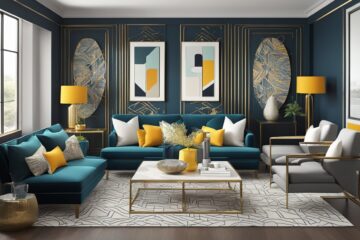Are you a new property owner looking to add your personal touch to your home? If so, you may wonder what an interior design mood board is and how it can help you achieve your vision. Keep reading to learn everything you need about interior design mood boards!
What is a mood board and why do you need one when designing your home’s interior?
A mood board is an excellent tool for property owners who want to create the perfect home interior. It’s an inspirational collage of ideas, textures, colours and fabrics to communicate your design concept visually. A mood board helps to identify what elements you like and decide on a cohesive look for rooms in your home. Without one, you may find yourself second-guessing decisions or not knowing which direction to go to create an overall aesthetic that matches your vision for your space. When put together thoughtfully, a mood board can be used as guidance when shopping or renovating – acting as a comprehensive source of inspiration with all the ideas pulled into one visual display.
How to create a mood board that reflects your personal style
Creating a mood board is a great way to capture your vision for your interior design project. Mood boards make it easy to collect inspiring images from magazines, online sources, and other materials. You can mix and match pieces of different styles together to express your taste and customize the look for each room in your home. When creating a mood board, pick items representing the feeling or atmosphere you want to bring into the space. Try thinking about colour schemes that best suit your personality and what type of furniture fits your desired design aesthetic. Visualizing options before starting construction will ensure that you love the final product!
Tips for using a mood board to help you make decisions about furniture, paint colours, and more
A plan for your interior design project can help you make decisions and stay organized. Creating a mood board is a great way to capture your dream space’s look and feel visually. As you create your mood board, think about crucial elements like furniture, wall colours, artwork, area rugs, and window treatments. These items can help define the overall tone of a room. Gather inspiration from magazines, websites, or even friends’ interiors to help decide what fits best with your style. As you refine your ideas into a visualization on the mood board, it will make it easier to narrow down which pieces are suitable for your room and give you more confidence when making decisions that reflect your personality!
How to change up your mood board as your tastes evolve over time
When it comes to interior design, a mood board can be an excellent way for new property owners to experiment with different looks and styles; however, as time goes on, their tastes may evolve. That’s why refining and updating your mood boards from time to time to reflect your changing tastes is essential. By doing so, you create an updated source of design inspiration and guarantee that your interior appropriately matches the vision you have in mind. Switching out colours and patterns is also a good idea if you’re looking for subtle ways to change your overall aesthetic. Overall, regular updates of your mood boards are key to add the necessary variety while maintaining consistency within the home space.
Why it’s essential to keep your mood board updated as you complete your home design project
For those starting a home design project, keeping your mood board updated is one of the most important steps you can take to ensure successful results. Whether selecting furniture pieces or selecting a colour palette that adds character to each room, creating a visual representation of your vision for your space will help bring the concept to life. A mood board takes the guesswork out of shopping for furniture and materials and ensures that any new additions will meet the configuration detailed on the mood board, preserving the look and feel desired. Updating mood boards as ideas develop keeps your property project on track and keeps you organized as various components come together. For owners embarking on any home design mission, being mindful of updating their mood board throughout their process can be an essential part of seeing beautiful final results.
Mood Board FAQs
What are the 4 components of a mood board?
A mood board is an effective tool used in many creative projects, often used to promote an idea and allow a creative team or a single individual to brainstorm together. It is essential to understand the four components of creating a successful mood board; vision, samples, palette and typography. An adequate vision should incorporate how one wants the project to look, feel and convey emotions. Samples that fit within this vision have been gathered in the form of text blocks and imagery related to one’s idea. The sample selection should be relevant but wide enough for viewers to understand your initial vision. A colour palette or palette of feelings can also be selected depending on what you are trying to capture; a muted feeling or something more vibrant? This ties into typography choices that will add further layers to your mood board – whether looking for bold fonts with solid messages, ornate typefaces with a traditional influence, or simple typefaces with elegant punches. With these four components incorporated into your creativity, your mood board can allow you to effectively explore innovative ideas and bring them all together into a single concept!
What is the difference between a mood board and a design board?
When it comes to product design, a mood board and a design board are extremely important. A mood board is typically used early in the design process as it inspires the project’s direction. It is usually made up of visuals such as photos, illustrations and colours chosen to evoke certain emotions and feelings. A design board then takes this concept further by combining typography and interface designs. In essence, it functions as a mockup or prototype of the finished project, allowing professionals to test different aspects before committing to any decisions. While both devices are helpful in their way, it is clear that each plays an integral role in achieving a successful end product.
How do you make an interior design sample board?
An interior design sample board is an excellent tool for quickly visualizing a space and getting ideas for decor. It allows designers to explore different colour schemes, materials, textures, fabrics, and other decorative elements that would work well in the designated area. To make a sample board, start by gathering fabric swatches, paint chips and any other samples you want to include. Next, arrange them onto the board – keeping colour palettes together and containing small items such as lamp bases or knobs – until you have created a visually appealing representation of your design concept. Finish by sealing the samples with a clear coat spray sealer to protect them from damage. This simple process allows you to create your own interior design sample boards and take your creative vision to reality.
How can I make an interior design mood board for free?
Making an interior design mood board is a great way to get your creative juices flowing and start bringing together ideas for a project. You can construct the perfect mood board with suitable materials and inspiration to help develop and refine any concept. And what’s great is that it doesn’t have to cost you anything! Thanks to DIY projects, modern technology, and endless design opportunity, there are plenty of ways to make an interior design mood board without breaking the bank. Projects like these are also incredibly rewarding when you discover how much you can achieve with simple household items. Plus, let’s not forget the array of free online templates now available, which make creating a stunning board as easy as ever!
Is there an app to create a mood board?
Yes, there are several apps available for creating mood boards. Some popular options include:
1. Adobe Spark: This app allows you to create professional-looking mood boards 2. Use a variety of templates and design elements.
2. Canva: This app offers a wide range of design templates, including mood board templates, that can be customized to suit your needs.
3. Moodboard Lite: This app is specifically designed for creating mood boards and offers a variety of tools and features to help you create a visually appealing mood board.
4. Moodboard Pro: This is an advanced version of Moodboard Lite with more features and functionalities.
5. Pinterest: This app is not designed explicitly for creating mood boards, but it can be used as a tool to create a visual inspiration board by creating boards and pinning images to them.
How do you lay out a mood board?
A mood board is a visual representation of a design concept and can be created in various ways. Here are a few tips for creating a mood board:
1. Define your concept: Before you begin creating your mood board, you must clearly understand the overall concept or theme you want to convey. This will help guide your selection of images, colours, and other design elements.
2. Gather inspiration: Collect various images, colours, textures, and other design elements that align with your concept. You can find inspiration from magazines, websites, social media, and real-life objects.
3. Choose a layout: Decide on a layout that best showcases your concept. This could be a grid, a collage, or a more free-form layout.
4. Use a variety of elements: Use a mix of images, colours, textures, and other design elements to create visual interest and convey your concept.
5. Keep it organized: Keep your mood board organized by grouping similar elements together and using a consistent colour palette.
6. Use software or a physical board: You can use software, an app or a physical board to organize your mood board.
7. Label your mood board: Label your mood board with the concept or theme, date, and other relevant information.
Conclusion
In conclusion, creating a mood board is essential when redesigning your home’s interior. A good mood board should reflect your style and identity accurately, so take time to express yourself and explore different design elements to find the combinations you like best. Furthermore, these boards can prove invaluable as you progress through your interior decorating project; use them to make decisions about paint colours, furniture, fabrics and more! Don’t forget templates come in handy for revamping and changing the look with every season. Finally, remember that keeping the mood board updated will ensure that you continue to bring your integrated vision into any space while maintaining a grandiose scheme of colour, shape and texture that is uniquely yours.


